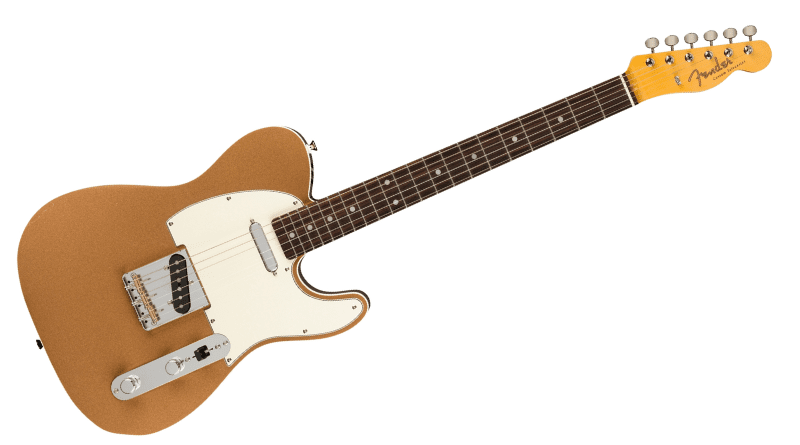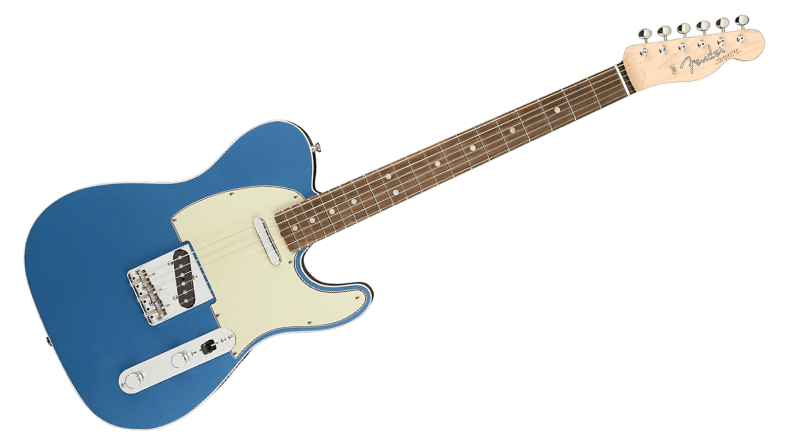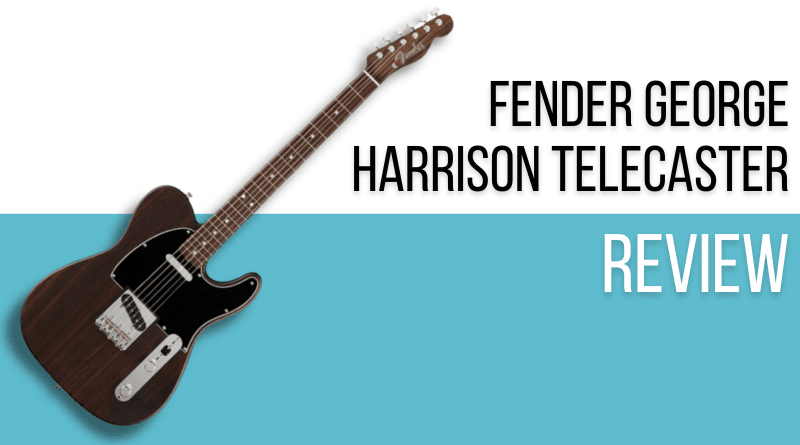Fans of the Beatles will immediately recognize this stunning edition of Fender’s classic Telecaster. The Beatles’ lead guitarist, George Harrison, used this guitar on some of the group’s most successful hits, and it was even his guitar of choice during their final rooftop performance.
Fender has produced a run of reproductions of this incredible guitar, and we were fortunate enough to get hands on with one for this KillerGuitarRigs review. We wanted to find out whether it really stands out from other Telecasters, or whether Beatlemania has hyped it up unnecessarily.
Keep on reading to find out what we thought.
Read more about our review process.
Contents
Who Is This For?
This is a high end, US made Telecaster, designed for serious musicians, as well as the Beatles fan who has everything. It’s built to the specs of Harrison’s original, albeit with some minor modernizations that we’ll cover below, so it’s clear this is very much a player’s guitar, rather than a collector’s piece.
Appearance / Features / Controls
The most striking thing about the George Harrison Telecaster is that it has a natural rosewood body – if you’re at all familiar with the model, you’ll know that this is not a wood that is simple used for the body or neck of these guitars, so immediately it stands out.
The body on our test model was made from 2 pieces of rosewood, and although it wasn’t visible, there was a maple spacer. Unlike the original, this reproduction was in fact weight relieved with chambers in the body. Rosewood is an incredibly dense, heavy wood, and without this weight relief it would have been exceedingly uncomfortable to hold.
The neck, headstock, and fretboard, if you hadn’t already guessed, were also made from rosewood. The neck was a bolt on, which is true to the overall design of the Tele. It had a mid ‘60s C shape profile, which was quite hefty, and really best suited to players with big hands.
It was equipped with 21 medium jumbo frets, which worked well with the factory setup. The fret ends were about as perfect as fret ends can get and the crowns were perfectly level and finished to a mirror shine.
As for the rest of the hardware, it had a synthetic bone nut, and a 3 saddle vintage barrel style bridge. The tuners had the more contemporary style buttons, but the machines were vintage F stamped units with sealed gears.
Ensuring that this model was period correct, Fender equipped it with the original ’64 grey bottom single coil pickups, and cloth covered wiring. These electronics ensure that it gets as close as possible to sounding like George’s original guitar.
Performance / Sound
Fender’s efforts to reduce the weight of the George Harrison Telecaster definitely didn’t go unnoticed. The test model weighed in at around 7.5lb, which is svelte compared to the almost 11lb that the original weighed. So, despite being made from an incredibly dense wood, it was very comfortable to hold and play.
Playability was fairly typical for a Telecaster. It had no belly carves or any kind of contouring. It was a slab body guitar so playing while seated wasn’t the most comfortable, but holding it while standing was fine.
The neck performed really well. It felt fantastic in the hand, and despite being on the chunkier side, it was fast, and didn’t cause any issues with fatigue.
We really enjoyed the factory setup. Of course, it’s difficult to say if it was set up to George’s specs, but we found the action to be dead on perfect for a telecaster. Nice and low, and with the modern 9.5” radius, we didn’t have any issues with notes choking out. Intonation was excellent, and that’s not an easy thing to accomplish with these 3 saddle bridges.
The tones from this Tele were absolutely wonderful, but in all honesty, we felt that the rosewood had a much bigger impact on the aesthetics than it did on the sound. It had a very slightly warmer tone than a typical Telecaster, but it was marginal, and ultimately sounded similar to any other 1960s model. Of course, this is by no means a bad thing. It offered immense clarity, and we still got the twang that you expect from a Telecaster.
The pickups really performed well across a range of genres, and were quite a lot hotter than modern Tele pups, and the alnico V magnets provided excellent responsiveness.
Other Guitars to Consider
The Fender George Harrison Telecaster is a stunning guitar, but it was from a highly limited run of just 1000 guitars. If you aren’t lucky enough to get your hands on one, here are some great alternatives to consider.
Fender JV Modified ‘60s Telecaster

The Fender JV Modified ‘60s Telecaster is a modern take on the Japanese made 80s reissues of Fender’s 1960s models. It offers similar ‘60s hardware and aesthetics, without the rosewood. While it doesn’t have the same authentic ’64 pickups, the pickups it does have feature a vintage voicing that’s perfect for capturing the ‘60s sound.
Fender Original ‘60s Telecaster

Again, this alternative does away with the rosewood in favor of more traditional Telecaster tonewoods like alder, but, being a Fender Original ‘60s Telecaster model, it offers similar playability and tones to the Harrison signature. It has a similar ‘60s C profile neck, the same Pure ’64 pickups, and the same 3 saddle vintage bridge. If you want the sound, and the looks aren’t a dealbreaker, this could be the next best option.
Final Thoughts on the Fender George Harrison Telecaster
The Fender George Harrison Telecaster is a gorgeous guitar, there’s no doubt about it, the rosewood is spectacular, and the quality of fit and finish is impeccable. However, it doesn’t play much differently than a regular ‘60s Original Telecaster, and nor does it sound dramatically different, which leads us to conclude that if you’re a huge Beatles or George Harrison fan, and the look is a dealbreaker, then go ahead with the rosewood model – we’re sure you won’t be disappointed. But, if the looks aren’t so important, Fender offers a number of other avenues to get practically the same sound.


